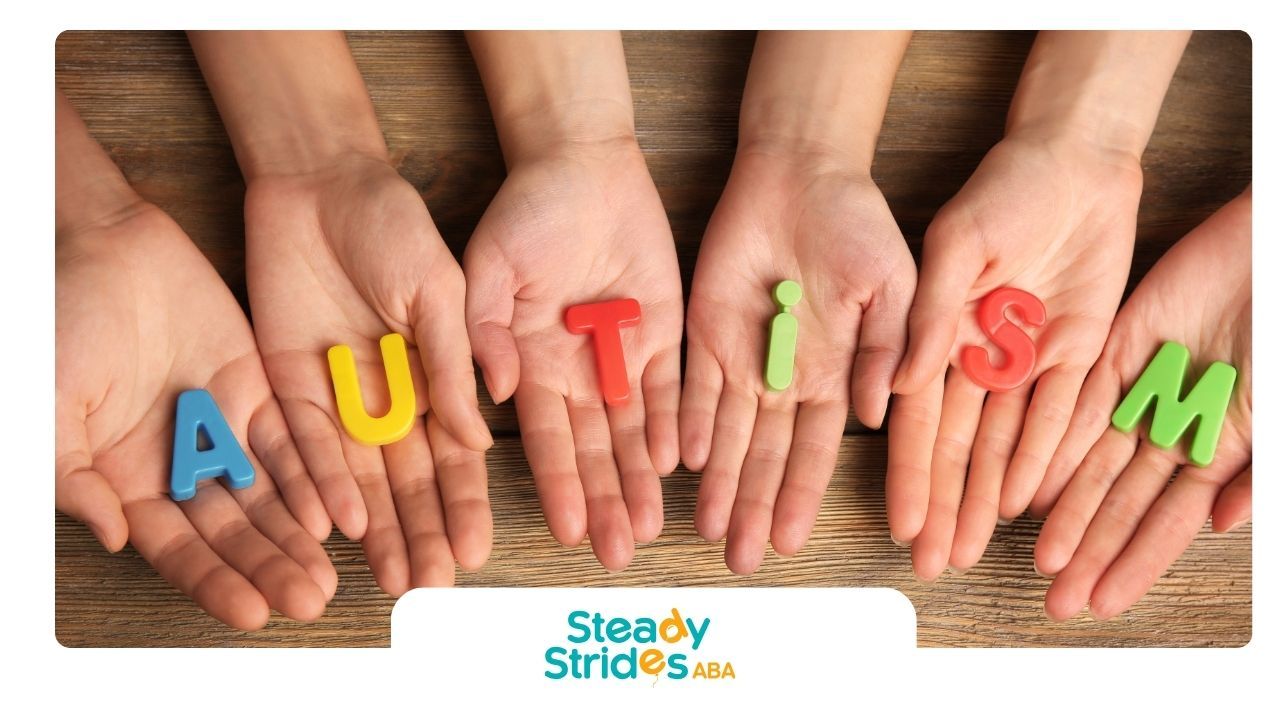Stimming behaviors like rocking and hand-flapping are often found in autism spectrum disorder. Many autistic children use stimming to help them manage their senses and express their emotions. Caregivers might wonder if ABA therapy (Applied Behavior Analysis) aims to stop stimming completely. However, ABA therapy seeks to understand these behaviors. It looks at stimming to help manage sensory input and keep a good balance between learning skills and expressing oneself, while also valuing neurodiversity.
Understanding Stimming and Its Significance
Stimming, or self-stimulatory behavior, is an important part of the daily lives of many autistic individuals. These repetitive movements, like spinning or humming, help children manage their sensory and emotional needs.
Stimming can look different for each person and serves many purposes. It can help reduce stress or deal with sensory overload. Recognizing the value of these behaviors leads to kindness in support, helping to create a supportive environment.
Defining Stimming in the Context of Autism
Stimming means doing repetitive movements or sounds. Many people on the autism spectrum show these behaviors. Some examples are rocking, hand-flapping, or making certain sounds. These actions might seem odd, but they often serve important purposes. Stimming is completely normal and is part of how all humans behave, like pacing or tapping.
For those on the autism spectrum, stimming helps them manage sensory input. The repeated actions bring comfort and predictability in overwhelming situations. This gives relief to individuals who deal with sensory processing issues.
For many autistic children, stimming is also a way to communicate. For example, hand-flapping can show excitement, while rocking might mean they feel uncomfortable. By understanding this, caregivers and therapists can see that stimming is more than just a repetitive action. It is also a way to express thoughts and feelings.
The Psychological and Emotional Roles of Stimming
Stimming has important psychological and emotional benefits for autistic individuals. It helps children regulate their emotions. This means they can deal with stress, anxiety, or excitement by using a familiar way to express those feelings.
Stimming also helps manage sensory overload. For example, movements like rocking can block out outside distractions. This makes the child feel safe and stable in their surroundings.
Moreover, stimming serves as a way to relieve stress, helping children relax during tough times. Activities like scribbling or humming can calm down emotional stress. Understanding these benefits can improve support practices, ensuring that stimming is not seen as a problem, but is recognized and gently supported.
ABA Therapy's Approach to Stimming
ABA therapy focuses on understanding why a child stims and how it affects their life. Modern methods create customized plans that respect individual needs and work on harmful or disruptive stimming behaviors.
Therapists look for what triggers stimming and its purpose. They decide if any changes are needed. The main goal is not to stop stimming completely but to help find alternative ways to cope or redirect behavior only when stimming is harmful or disrupts daily activities.
Historical Perspective on ABA Therapy and Stimming
In the past, ABA therapy tried to change stimming behaviors that people thought were disruptive or not socially acceptable. This meant making autistic individuals fit into typical behavior standards. The focus was on stopping repetitive actions like rocking or humming instead of understanding why stimming happens.
Over time, things changed. Modern ABA therapy now sees stimming as more than just a bad habit. It looks at how stimming can help with sensory experiences, emotions, and communication. Experts realized that stopping stimming without figuring out what causes it could be harmful.
Today, ABA therapists use behavior analysis to understand stimming's role in a child's life. Instead of just making strict changes, they focus on understanding the child's needs and promoting safe ways to express themselves while honoring their individuality.
Current Practices in ABA Regarding Stimming
Modern ABA therapy sees stimming as a natural behavior instead of something to remove. Therapists look for times when stimming might be unsafe or get in the way of learning. They suggest other ways to cope only when it is necessary.
| ABA Practice | Example |
|---|---|
| Sensory Regulation Tools | Fidget toys or weighted blankets |
| Behavior Redirection | Switching rocking with squeezing stress balls |
| Structured Breaks | Scheduled stimming moments in routines |
ABA therapists create personalized plans for each child. The focus is on teaching safer behaviors and suggesting socially acceptable options when severe stimming could be a problem, like at school or during social events.
Supporting neurodiversity is a key part of modern ABA methods. These methods aim to help children with self-regulation and honor their unique traits.
Ethical Considerations in Modifying Stimming Behavior
Ethical choices are very important when deciding on stimming interventions in ABA therapy. It is crucial to balance therapy goals with respect for each child’s unique traits to ensure a thoughtful approach.
Therapists look closely at why a child is stimming. They only step in when the behaviors could be harmful or greatly disrupt daily activities. Today, it is considered wrong to try to stop stimming just to make things seem normal. Instead, ABA focuses on encouraging safe and useful ways for children to express themselves. This keeps the child’s independence and their neurodiverse identity intact.
Balancing Therapeutic Goals with Individual Needs
Effective ABA therapy works best when it balances goals and the different needs of autistic individuals. Therapists focus on methods that honor the child’s natural behaviors while handling problems or risks when needed.
Some key points are to adjust methods to fit individual goals. For instance, during school, stimming can be redirected to more functional behaviors while keeping its sensory or emotional benefits. Allowing safe and suitable stimming helps children meet both their therapy goals and personal wants.
By improving communication and social skills while valuing diverse expressions, ABA shows its dedication to personalized and ethical ways of addressing stimming behaviors.
Advocating for Respectful and Non-Coercive Methods
ABA therapy uses respectful and gentle methods to handle stimming. This way, children feel supported, not pushed to change. Therapists follow these ethical points:
- Respect neurodiversity by accepting harmless stimming. These behaviors help with feeling better and showing emotions.
- Focus on safety by acting only when stimming hurts the child or interrupts learning.
- Collaborate with caregivers to ensure therapy fits with family beliefs.
By using these methods, ABA therapy avoids forcing children. Instead, it aims to build supportive spaces. This therapy helps with personal growth and boosts self-esteem while respecting each child's uniqueness.
Practical Strategies Within ABA to Support Stimming
ABA therapy uses different strategies to support stimming in a positive way. These methods help autistic individuals to manage their emotions while also engaging with others. This allows them to thrive in many different environments.
Therapists often recommend safe alternatives or work on making stimming more socially acceptable while keeping its sensory benefits. By identifying what triggers stimming, offering sensory toys, or creating calm spaces, ABA therapy makes sure that the child's choices and well-being are respected.
Alternative Techniques to Manage Stimming
Alternative coping strategies are important in ABA therapy for managing stimming. By channeling sensory input into organized activities, children can lessen disruptive stimming while still expressing themselves.
Therapists might introduce deep pressure methods, sensory-friendly tools, or physical activities like jumping and stretching to meet sensory needs. Having structured schedules helps anticipate triggers and provides specific times for stimming, ensuring safe and socially aware moments.
These methods connect with autistic children in a meaningful way. They build trust and flexibility in ABA practices.
Encouraging Functional and Safe Stimming Behaviors
ABA therapy helps children use stimming safely and effectively as part of their daily activities. Functional stimming can improve their focus and help with emotional regulation by providing sensory input.
If stimming becomes harmful, therapists suggest safe alternatives. For example, they might guide a child who picks at their skin to use fidget toys instead. In places like schools or public settings, ABA therapists show kids how to make stimming more socially acceptable, like changing rocking into using stress balls that they can squeeze.
These methods allow children to express themselves while also promoting good practices in different situations.
Conclusion
In conclusion, it is important to understand how Applied Behavior Analysis (ABA) relates to stimming. This knowledge helps create a supportive and respectful space for people on the autism spectrum. Some may think ABA tries to stop stimming, but today’s methods focus on personal choice, emotional health, and practical skills. By promoting ethical practices that meet individual needs, professionals can use techniques that respect stimming and encourage safe ways to cope. As we learn more about autism therapy, it’s vital to stay informed and caring, making sure everyone gets the understanding and support they need. If you want to learn more or need help, feel free to ask your questions— we are here to assist.
At Steady Strides ABA, serving families across Texas, we understand the importance of addressing concerns and misconceptions surrounding ABA therapy. This article explores the truth about whether ABA aims to stop stimming behaviors in autistic individuals. Our approach at Steady Strides ABA prioritizes understanding the function of stimming and focuses on reducing behaviors only when they are harmful or significantly interfere with learning and daily life. We emphasize teaching functional communication and replacement behaviors, respecting individual differences and sensory needs. Steady Strides ABA is committed to providing ethical and person-centered ABA therapy in Texas that promotes well-being and skill development while respecting the unique expressions of autistic individuals. We aim to empower families with accurate information and effective strategies.
Frequently Asked Questions
What are the most common misconceptions about ABA and stimming?
One big misunderstanding is that ABA therapy wants to stop all stimming. Modern ABA understands the sensory and emotional roles of stimming. It only focuses on stimming when it affects learning or could be harmful. Therapists work to find safe and supportive options while valuing individual needs and different behaviors people have.
Source:
https://www.autismspeaks.org/applied-behavior-analysis
https://www.healthline.com/health/autism/stimming
https://www.mayoclinic.org/diseases-conditions/autism-spectrum-disorder/symptoms-causes/syc-20352928
https://blossomabatherapy.com/blog/does-aba-try-to-stop-stimming-exploring-the-controversy?utm_source=google&utm_medium=cpc&utm_campaign=21354697388&utm_content=164795214842&utm_keyword=counseling%20for%20autism&device=c&gad_source=1&gclid=Cj0KCQiAoae5BhCNARIsADVLzZdTbteZSxtnrMqu8uT39kymOPrSVmMo1BGJbxIlf-HM9ZeevqeRs1MaAgy7EALw_wcB













